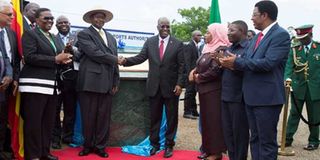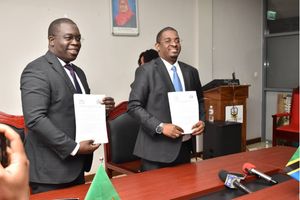Leaders optimistic on oil pipeline deal

President John Magufuli and his Ugandan, Yoweri Museni (left) shake hands after laying foundation stone for the construction of the 1,445-km Hoima-Tanga crude oil pipeline at Chongoline Village in Tanga yesterday. PHOTO| VPO
What you need to know:
- President John Magufuli and his Ugandan counterpart, Yoweri Museveni laid the foundation stone for the ambitious project at Chongoleani, in the port city of Tanga yesterday.
Tanzania and Uganda are optimistic that their $3.5 billion crude oil pipeline deal stands to benefit all the economies of the East African region.
President John Magufuli and his Ugandan counterpart, Yoweri Museveni laid the foundation stone for the ambitious project at Chongoleani, in the port city of Tanga yesterday.
The two leaders were upbeat as they flagged off work on the pipeline that will take Uganda’s crude oil to export markets.
In their speeches to the gathering, they reiterated their commitment to see the success of the much-hyped crude oil pipeline, which is expected to start pumping Ugandan oil to international markets in three years.
At a ceremony that attracted thousands of Tanga residents to Chongoleani village, some 30km from town, the two heads of state laid the foundation stone for the construction of the pipeline expected to start next January.
Accompanied by delegates from both countries - they assured project investors and contractors that their funds were in safe hands to pursue Africa’s longest oil pipeline, and were optimistic that it would not only improve exports, but also transform the lives of the region’s citizens.
President Museveni reiterated that Tanzania and Uganda should not be taken as the sole beneficiaries of the 1,445 kilometre pipeline, but rather the entire region.
He cited, for example, the fact that once Uganda starts refining petroleum products, regional airlines may gain more or increase their profits due to the availability of cheap aviation fuel.
The pipeline was earlier planned to go through Mombasa Port in Kenya, but Tanzania finally won the deal following intensive lobbying.
Tanzania agreed to give some concessions like tax holidays and a free corridor for building the pipeline. President Museveni said corporate tax, value-added tax (VAT) were also exempted as part of efforts to reduce the cost of the project.
According to him, the government of Tanzania also promised to take up a fair share in the pipeline.
All those make the project profitable, despite the fact that oil prices dropped from an average of $120 per barrel to $50, said Mr Museveni. According to the project report, the 24-inch diameter pipeline will move 216,000 barrels of oil per day at a cost of about $12.2 per barrel.
“East Africa and specifically Uganda is respectable now. We are ready for transformation of our people. We don’t want a peasant to generate another peasant,” said Mr Museveni during his speech.
The project will become “the longest electrically heated crude oil pipeline in the world”.
The pipeline will be pre-heated and covers 1.2 metres underground. There will be temporal facilities such as coating plants and pipe storage yards, access roads, burrow pits, hydro-test dams, a marine terminal and a jetty. The pipeline is expected to be completed by 2020.
Dr Magufuli described Museveni as not only a friend to Tanzania but a relative, considering his historical background.
Mr Museveni studied in Tanzania and three of his children were born in the country, said Dr Magufuli.
President Magufuli asked contractors of the Hoima -Tanga pipeline to expedite and complete the planned construction before 2020 for East African countries to start benefiting from their own oil.
“Three years is too long and you can finish before that time if you work day and night,” he said. He also assured the public that anyone who is evicted to pave the way for the pipeline will be compensated in accordance with the law.
He promised to expand the Tanga Port after the Regional Commissioner, Mr Martin Shigela asked him to intervene. Mr Shigela said Tanga needed to now accommodate big ships.
Speaking at the event, Vice President Samia Suluhu Hassan said such projects would realise the dream of EAC of growing together economically.
“This project manifests our development agenda as a region. It is now the high time for EAC countries to walk the talk; we have had a number of meetings in the past, now we should implement the envisaged projects effectively,” she said.
Contractors committed
The pipeline will be heated so it can keep the highly viscous crude liquid enough to flow.
Total is one of the owners of Ugandan oilfields, alongside China’s Cnooc and Britain’s Tullow Oil. Total has said it is willing to fund the pipeline’s construction but has not what stake it will own in the project.
The pipeline starts from landlocked Uganda’s western region, where crude reserves were discovered in 2006.
, and terminate at Tanzania’s Indian Ocean seaport of Tanga.
Uganda estimates overall crude reserves at 6.5 billion barrels, while recoverable reserves are seen at between 1.4 billion and 1.7 billion barrels.
Total said it was committed to the project and would deliver as expected. “We have been in East Africa for a long time and we are committed to deliver this project to your expectations,” said Total president Mr Patrick Pouyanné.




